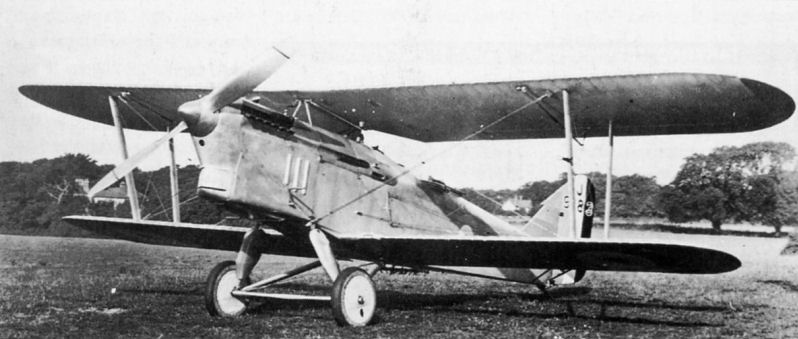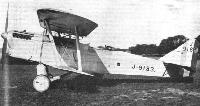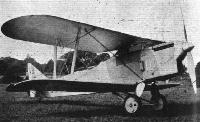Avro серии 604 Antelope
Avro серии 604 Antelope появился как претендент на серийное производство по спецификации 12/26 Министерства авиации. Он конкурировал с Fairey Fox Mk IIM и Hawker Hart, а учитывая отличные характеристики этих машин, неудивительно, что довольно обычная конструкция "Avro" не вышла за стадию прототипа. Antelope поднялся в воздух в середине лета 1928 года. В соответствии со спецификацией это был двухместный цельнометаллический биплан. Стрелок-бомбардир, сидевший в задней кабине, мог лечь на пол и занять место у бомбоприцела. После оценочных испытаний, где выявилось, что машина удовлетворяет большинству предъявляемых требований, ее отправили на эксплуатационные испытания. Но там она стала только третьей, уступив Hawker и Fox IIM. Затем самолет вернули на завод для установки двойного управления и отправили в Королевский НИИ авиации, где его использовали в различных экспериментах.
ТАКТИКО-ТЕХНИЧЕСКИЕ ХАРАКТЕРИСТИКИ
Avro серии 604 Antelope
Тип: двухместный дневной бомбардировщик
Силовая установка: один V-образный двигатель Rolls-Royce F. XIB мощностью 480 л. с. (358 кВт)
Характеристики: максимальная скорость 278 км/ч на оптимальной высоте; крейсерская скорость 233 км/ч на оптимальной высоте; начальная скороподъемность 448 м/мин; практический потолок 6705 м; дальность полета 933 км
Масса: пустого самолета 1297 кг; максимальная взлетная 2058 кг
Размеры: размах крыла 10,97 м; длина 9,50 м; высота 3,28 м; площадь крыльев 35,02 м
Вооружение: один синхронный пулемет калибра 7,7 мм, один турельный пулемет того же калибра в задней кабине, две 113-кг или четыре 51-кг бомбы под нижним крылом и четыре 9-кг бомбы под фюзеляжем
Показать полностьюShow all
Flight, June 1929
THE AVRO "ANTELOPE"
A High-Performance Day Bomber, which can also be used as a Two-Seater Fighter Reconnaissance or General Purpose Aircraft
DESIGNED primarily as a high-performance day bomber, the Avro "Antelope” shown in the accompanying illustrations possesses qualities of speed, manoeuvrability and general performance which render it particularly suitable for the alternative use as a two-seater fighter, reconnaissance or general purpose aircraft. The aerodynamic design is simple and straightforward, and the all-metal construction makes use chiefly of duralumin, with highly-stressed parts and fittings of stainless steel.
Apart from aerodynamic efficiency, the designer of a military aircraft is always faced with the problem of providing as good a view as possible for the crew. In the "Antelope" this has been attempted in the following manner: The biplane wings, of which the upper is of larger span and chord than the lower, are given a considerable sweep-back, so that, although the attachment to the fuselage is fairly far forward, both cockpits are aft of the upper wing. In addition, the forward (pilot's) cockpit is raised so as to bring its coaming near the top plane. Moreover, the pilot's seat is adjustable in such a manner that he can raise and lower himself during flight to the height which gives him the best view for fighting. The lower plane is well set back on the fuselage, and its narrow chord affords a good view in a forward and downward direction, both for fighting and for landing. The fuselage itself is narrow, and with a cambered deck, which slopes down towards the nose, thereby further improving the view forward. Finally, the top wing, whose spars are attached at the centre to a cabane, taper down to quite a small thickness on the centre line, so that here again the view is obstructed to as small an extent as possible.
The rear cockpit for the bomber or gunner is behind that of the pilot, and on a slightly lower level. The mounting for the Lewis gun is of the special "Avro" type, having special patented features, including a wind-balanced device enabling the gunner to work his machine gun while the machine is travelling at high speed. A very wide field of fire is provided for this gun, and "blind spots" are reduced to a minimum. The pilot is provided with the usual Vickers gun, firing forward "through" the propeller by means of an interrupter gear.
Bombs are carried on bomb racks under the lower wing, and a prone bombing position is provided in the fuselage, with a sliding window in the floor.
Constructional Features
In the construction of the fuselage of the Avro "Antelope” duralumin is used extensively. The structure is of the type in which the skin or planking assists in resisting loads, and consists mainly of L-section longerons and other members, to which the flat plate covering is riveted. The front portion of the fuselage, or more accurately the engine mounting, is a welded steel tube structure, separated from the fuselage proper by a fireproof bulkhead.
The wings also are of all-metal construction., with spars and ribs of duralumin, but with fabric covering. All wing fittings are of stainless steel.
The tail surfaces have a welded steel tube structure covered with fabric, and the tail plane is of the trimming type, with a control wheel in the pilot's cockpit.
The undercarriage is of the oleo and rubber compression type, with long travel. It has the usual wheel axle, and bracing is in the plane of the rear struts or radius rods, the front legs being telescopic. The tail skid consists of a leaf spring with a shoe of chilled cast iron. Bouncing is reduced by the friction between the laminations of the leaf spring, and this type of tail skid has proved very successful.
Concerning the engine installation, &c, it may be pointed out that the Rolls-Royce F type engine is cooled by means of a honeycomb radiator mounted under the nose of the fuselage and housed in a tunnel. The usual shutters are provided for varying the amount of cooling. There are two fuel tanks, a main and a gravity tank, both mounted in the fuselage behind the fireproof bulkhead.
Dimensions. - Following are the main dimensions of the Avro "Antelope": Length o.a., 31 ft. 2 ins.; wing span (top), 36 ft.; wing span (bottom), 32 ft.; chord of top wing, 7 ft.; chord of bottom wing, 5 ft.; total wing area (including ailerons), 377 sq. ft. Area of tail plane and elevator, 43-1 sq. ft.; area of rudder, 15-4 sq. ft.; area of fin, 4-3 sq. ft.
Weight, &c. - The structure weight of the "Antelope" is 1,350 lbs., made up as follow: - Wings, 545 lbs.; tail, 83 lbs.; undercarriage, 171 lbs.; fuselage complete, 551 lbs. The complete power plant weighs 1,337 lbs., the single items and their weights being :- Engine with airscrew boss, 883 lbs.; exhaust pipes, 11 lbs.; radiator, 71 lbs.; water (total), 97 lbs.; airscrew, 120 lbs.; petrol tanks, 44 lbs.; oil tanks, 7 lbs.; water tank, 4 lbs.; starting gear, 21 lbs.; piping, accessories, &c, 79 lbs.
The total weight of the machine empty is 2,687 lbs., and the disposable load is 1,852 lbs., giving a total gross weight of 4,539 lbs.
Performance. - When the "Antelope" is fitted with the Rolls-Royce F.XI B. engine, the performance is as follows :- Maximum speed at 5,000 ft., 173 m.p.h.; at 10,000 ft, 167 m.p.h.; at 15,000 ft., 157 m.p.h.; at 20,000 ft., 136 m.p.h. Cruising speed, 150 m.p.h. Landing speed, 60 m.p.h. Duration at cruising speed, 4 hrs.
Rate of climb at ground level, 1,470 ft./min.; at 3,000 ft, 1,520 ft./min. Time to 1,000 ft., 0-7 min.; to 5,000 ft., 3-6 mins.; to 10,000 ft., 8-2 mins.; to 15,000 ft., 15-5 mins.; to 20,000 ft., 32-3 mins. Service ceiling (i.e., height at which rate of climb has dropped to 100 ft./min.), 20,700 ft. Absolute ceiling, 22,500 ft.
Показать полностьюShow all
Flight, June 1929
BRITISH AIRCRAFT AT OLYMPIA
A. V. ROE & CO., LTD.
OWING to the fact that the material dealing with the exhibits of A. V. Roe & Co. reached us very late, it has not been possible to include the article describing the Avro show machines in its proper place, alphabetically, and we have, perforce, had to place it here, at the end of our advance show report. While regretting the fact, we had no choice in the matter, as it was necessary to go to press with this week's issue of FLIGHT a good deal earlier than usual, and the makeup of the Olympia Show Report could not be deferred until the last minute.
At least four complete aircraft are expected to be shown on the Avro stand; An Avro 10, an Avro 5, an "Antelope," and a metal "Avian" with "Genet Major" engine. This engine is an entirely new type, produced by Armstrong Siddeley Motors, Ltd., and will make its public appearance for the first time at Olympia,
<...>
The Avro "Antelope" is primarily intended for duty as a high-performance day bomber, but by reason of its speed, manoeuvrability and general design, it is particularly suited for service as a two-seater fighter, reconnaissance or general purpose aircraft.
The machine is a single bay biplane having a lower plane of smaller span and chord than the upper plane. "Frise" ailerons are fitted to the upper planes only, which are attached to a cabane, in the form of an inverted V, in front of the pilot's cockpit. At the point of attachment, the wing spars are tapered so that the section is such as to offer only the slightest obstruction to the pilot's view forward. This quality is further enhanced by the slope of the deck in a forward and downward direction and the rounding of the decking on each side. The height of the pilot's seat is easily altered, so that pilots of varying heights may take equal advantage of this arrangement of the upper main planes. It is also possible to alter the height of the pilot's seat during flight.
The main planes are slightly swept back and staggered, and owing to the small chord of the bottom plane, its leading edge is well behind that of the top plane, giving the pilot an excellent downward view.
The position of the bomber or gunner is aft of the pilot's cockpit and at a slightly lower level. The seat is adjustable. Particular care has been given to the arrangement and distribution of the armament and equipment.
The armament consists of one fixed Vickers gun firing forward through the airscrew and a Lewis gun in the rear cockpit.
The Lewis gun is mounted on a special Avro gun ring, having patented features and incorporating the wind balanced device. This type of mounting has a ring of smaller diameter than usual, and a very wide range is possible with the gun, which can be utilised to its fullest extent owing to the very narrow fuselage of this machine.
Bombs are carried on racks underneath the bottom planes, and a prone bombing position with a sliding window in the floor of the fuselage is provided.
The fuselage is of metal construction, and consists mainly of L angle duralumin channelling. It is covered with duralumin plates which are riveted on. This type of construction forms a rigid structure and no trueing-up is necessary.
The main planes are of all-metal construction, with duralumin spars and ribs, but all fittings are of stainless steel. The covering is of doped linen.
Welded steel tube construction is employed for the tail unit. The incidence of the tail plane may be altered during flight by means of a handweel in the pilot's cockpit.
The tail skid consists of a leaf spring with a wearing shoe of chilled cast iron. This type of skid has proved highly successful. Rebound is eliminated by the friction set up between the laminations.
The engine mounting is a welded steel tube structure, and is isolated from the fuselage by a fireproof bulkhead.
The undercarriage is of the Oleo and rubber compression type, with long oil travel, and is of particularly simple and clean design.
There are two fuel tanks, one main and one gravity, both situated in the fuselage immediately behind the fireproof bulkhead.
Cooling is by means of a honeycomb radiator carried in a tunnel, formed at the bottom of the fuselage. There is the usual shutter arrangement to vary the temperature.
The main dimensions of the "Antelope" are :- Length o.a., 31 ft. 2 in.; wing span (top), 36 ft.; wing span (bottom), 32 ft.; height o.a., 10 ft. 9 in.; chord of top wing 7 ft.; chord of bottom wing, 5 ft.; gap, 5 ft. 4 in.; total wing area, 377 sq. ft.
When fitted with the Rolls-Royce type F. XI B engine the "Antelope" has the following item weights: Structure, 1,350 lbs.; power plant, etc., 1,337 lbs.; total weight empty, 2,687 lbs.; useful load, 1,852 lbs. Total weight fully loaded, 4,539 lbs. This figure gives a wing loading of 12 lbs./sq. ft., and a power loading of 8-4 lb./h.p.
The performance of the Avro "Antelope" with the Rolls-Royce F XI B engine throttle-gated to 3,000 ft. is as follows: Maximum speed at 5,000 ft., 170 m.p.h.; at 10,000 ft., 165 m.p.h. ; at 15,000 ft., 155 m.p.h.; at 20,000 ft., 132 m.p.h. The landing speed is 63 m.p.h., and the cruising speed 145 m.p.h. The endurance at cruising speed is 4 hrs. Ground level rate of climb, 1,450 ft./min.; rate of climb at 3,000 ft., 1,500 ft./min. Time to 1,000 ft., 0-75 mins.; time to 5,000 ft., 3-8 mins.; time to 10,000 ft., 8-35 mins.; time to 15,000 ft., 16 mins.; time to 20,000 ft., 35 mins. Service ceiling, 20,000 ft. Absolute ceiling, 21,500 ft.
<...>
Показать полностьюShow all






